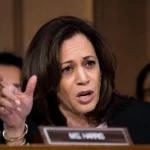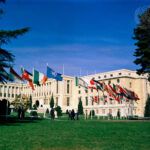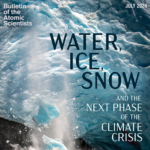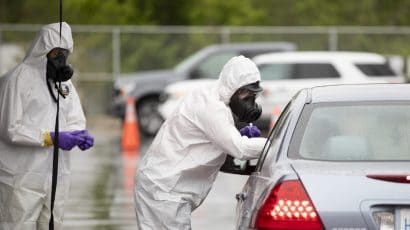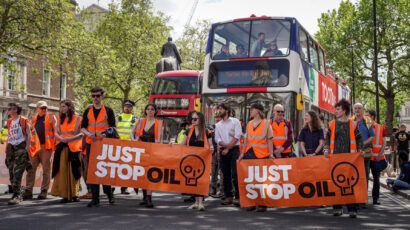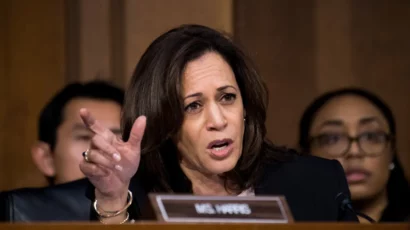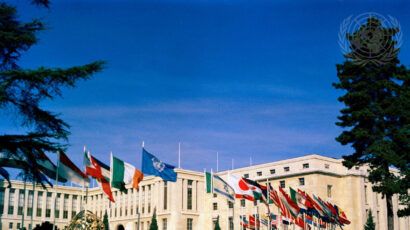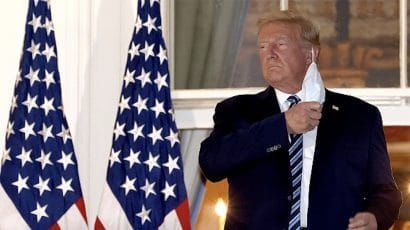A surprising success at Paris
By William Sweet | December 21, 2015
The two-week global climate conference that just ended in Paris, the 21st of the so-called Conferences of Parties held yearly under the 1992 UN Framework Convention on Climate Change, could not have been more different from the 2009 meeting in Copenhagen. There, the official agenda had called for a new comprehensive climate treaty to be negotiated, to succeed the 1997 Kyoto Protocol. Instead, just about everything that could go wrong did, starting with the overbooking of the conference center. A great many credentialed participants who had come from all over the world for a history-making meeting could not even get in. For days members of nongovernmental organizations stood in line in the cold, literally shut out of the proceedings. Some members of the press, this one included, found themselves in the same situation. With the mood turning sour, disruptions took place in the streets of the city, leading to many arrests. Meanwhile, a rebellion erupted among the diplomatic representatives of the developing countries when a leaked draft agreement circulated that seemed to call into question the fundamental principle of “common but differentiated responsibilities and capabilities,” a cornerstone of the Framework Convention established at Rio in 1992.
In Paris, the French erected a gigantic temporary conference complex in the suburb of Le Bourget, near where Charles Lindbergh landed in 1927. Everybody who was credentialed got in almost instantly on the first try, and we all got through security in a matter of minutes every day thereafter, despite the dreadful terrorist killings that had occurred just two weeks before. Shuttle buses ran around the clock to and from the nearest metro station, and all credentialed participants got all local transportation free of charge, compliments of the French hosts. Helpful guides were all over the place, not just at Le Bourget but in Paris rail and metro stations as well, at the ready to guide participants to their destination. Everybody—delegation members, NGO members, even members of the press—was in a good mood from day one. Everybody sensed that this time something historic really was going to happen.
In Denmark, management of the conference was uneven from the start, partly because of splits between the government, but partly also—to be frank—because the leaders of that little country seemed to be in way over their heads managing a very large, very complicated international conference. The French knew what they were doing. During the year before the conference, government leaders had travelled the world, conducting bilateral talks in anticipation of every sticky issue that could come up. President François Hollande went to Beijing, for example, and got the Chinese leadership to agree in principle that national climate pledges would be reviewed independently every five years—one of the most important elements, perhaps the most important element, in the accords to be negotiated. Foreign Minister Laurent Fabius, as official host of the meeting, took direct personal charge and by all accounts handled every detail beautifully, from the first day, when heads of state representing 150 countries convened, to the all-night negotiations during the final three days of the meeting.
In the opening leaders’ ceremony, featuring the secretary-general of the United Nations, the French president, the outgoing chairperson of the climate negotiations, and the chairperson of the climate secretariat in Bonn, everybody was reading from the same script. It was if they all had carefully compared notes before the meeting, and indeed, they almost certainly had.
Hollande, in his welcoming remarks, asked what would enable us to say the Paris agreement is good, even “great.” First, regular review and assessment of commitments, to get the world on a credible path to keep global warming in the range of 1.5–2.0 degrees Celsius. Second, solidarity of response, so that no state does nothing and yet none is “left alone.” Third, evidence of a comprehensive change in human consciousness, allowing eventually for introduction of much stronger measures, such as a global carbon tax.
UN Secretary-General Ban Ki-moon articulated similar but somewhat more detailed criteria: The agreement must be lasting, dynamic, respectful of the balance between industrial and developing countries, and enforceable, with critical reviews of pledges even before 2020. Ban noted that 180 countries had now submitted climate action pledges, an unprecedented achievement, but stressed that those pledges need to be progressively strengthened over time.
Remarkably, not only the major conveners of the conference were speaking in essentially the same terms, but civil society as well. Starting with its first press conference on opening day and at every subsequent one, representatives of the Climate Action Network, representing 900 nongovernment organizations, confined themselves to making detailed and constructive suggestions about how key provisions of the agreement might be strengthened. Though CAN could not possibly speak for every single one of its member organizations, the mainstream within the network clearly saw it was the group’s goal to obtain the best possible agreement, not to advocate for a radically different kind of agreement. The mainstream would not be taking to the streets.
This was the main thing that made Paris different, not just from Copenhagen, but from every previous climate meeting: Before, there always had been deep philosophical differences between the United States and Europe, between the advanced industrial countries and the developing countries, and between the official diplomats and civil society. At Paris, it was immediately obvious that everybody, NGOs included, was reading from the same book. So it was obvious from day one that an important agreement would be reached. National delegations would stake out tough positions, and there would be some hard bargaining. But at every briefing and in every interview, no matter how emphatic the stand, it was made clear that compromises would be made and nothing would be allowed to stand in the way of agreement being reached.
The Paris outcome. The two-part agreement formally adopted in Paris on December 12 represents the culmination of a 25-year process that began with the negotiations in 1990–91 that led to the adoption in 1992 of the Rio Framework Convention. That treaty, which would be ratified by all the world’s nations, called upon every country to take action to prevent “dangerous climate change” on the basis of common but differentiated responsibilities. Having enunciated those principles, nations were unable to agree in the next decades about just what they meant in practice. An attempt at Kyoto in 1997 foundered on the opposition of the United States to an agreement that required no action on the part of the major emitters among the developing countries. A second attempt at agreement in Copenhagen also failed.
Only with the Paris accords, for the first time, have all the world’s nations agreed on a common approach that rebalances and redefines respective responsibilities, while further specifying what exactly is meant by dangerous climate change. Paragraph 17 of the “Decision” (or preamble) notes that national pledges will have to be strengthened in the next decades to keep global warming below 2 degrees Celsius or close to 1.5 degrees, while Article 2 of the more legally binding “Agreement” says warming should be held “well below” 2 degrees and if possible limited to 1.5 degrees. Article 4 of the Agreement calls upon those countries whose emissions are still rising to have them peak “as soon as possible,” so “as to achieve a balance between anthropogenic emissions by sources and removals by sinks of greenhouse gases in the second half of this century”—a formulation that replaced a reference in Article 3 of the next-to-last draft calling for “carbon neutrality” by the second half of the century.
“The wheel of climate action turns slowly, but in Paris it has turned. This deal puts the fossil fuel industry on the wrong side of history,” commented Kumi Naidoo, executive director of Greenpeace International.
The Climate Action Network, in which Greenpeace is a leading member, along with organizations like the Union of Concerned Scientists, Friends of the Earth, the World Wildlife Fund, and Oxfam, would have preferred language that flatly adopted the 1.5 degree goal and that called for complete “decarbonization”—an end to all reliance on fossil fuels. But to the extent the network can be said have common positions, it would be able to live with the Paris formulations, to judge from many statements made by leading members in CAN’s twice- or thrice-daily press briefings, and statements made by network leaders embracing the agreement.
Speaking for scientists, at an event anticipating the final accords, H. J. Schellnhuber, leader of the Potsdam Institute for Climate Impact Research, said with a shrug that the formulation calling for net carbon neutrality by mid-century would be acceptable. His opinion carried more than the usual weight because he is sometimes credited in the German press as the father of the 2-degree standard. (Schellnhuber told me that a Potsdam team had indeed developed the idea of limiting global warming to 2 degrees in total and 0.2 degrees per decade; and that while others were working along similar lines, he personally drew the Potsdam work to the attention of future German chancellor Angela Merkel in 1994, when she was serving as environment minister.)
As for the tighter 1.5-degree standard, this is a complicated issue that the Paris accords fudge a bit. The difference between impacts expected from a 1.5-degree world and a 2-degree world are not trivial. The Greenland ice sheet, for example, is expected to melt in its entirely in the 2-degree scenario, while in a 1.5-degree world the odds of a complete melt are only 70 percent, points out climatologist Niklas Höhne, of the Cologne-based NewClimate Institute, with a distinct trace of irony. But at the same time the scientific consensus is that it would be virtually impossible to meet the 1.5-degree goal because on top of the 0.8–0.9 degrees of warming that already has occurred, another half-degree is already in the pipeline, “hidden away in the oceans,” as Schellnhuber put it. At best we might be able to work our ways back to 1.5 degrees in the 2030s or 2040s, after first overshooting it. Thus, though organizations like 350.org and scientists like James Hansen continue to insist that 1.5 degrees should be our objective, pure and simple, the scientific community and the Climate Action mainstream are reasonably comfortable with the Paris accords’ “close as possible” language.
‘Decision’ and ‘Agreement.’ The main reason why the Paris accords consist of two parts, a long preamble called the “Decision,” and a legally binding part called the “Agreement,” is to satisfy the Obama administration’s concerns about having to take anything really sticky to Congress. The general idea, which was developed by the administration with a lot of expert legal advice from organizations like the Virginia-based Center for Climate and Energy Solutions, was to put really substantive matters, like how much the United States will actually do in the next decades to cut its greenhouse gas emissions, into the preamble, and to confine the treaty-like Agreement as much as possible to procedural issues like when in the future countries will talk about what.
Nevertheless, the distinction between the Decision and the Agreement is far from clear-cut. All the major issues that had to be balanced in the negotiations—not just the 1.5–2.0 degree target and the decarbonization language, but financial aid, adaptation and resilience, differentiation between rich and poor countries, reporting requirements, and review—are addressed in both parts. There is nothing unusual as such about an international agreement having two parts, a preamble and main text. What is a little odd about Paris, however, is that the preamble, at 19 pages, is considerably longer than the 11-page Agreement, as Chee Yoke Ling of the Third World Network, who is based in Beijing, pointed out. The length of the Decision, she explained, reflects not only US concerns about obtaining Senate ratification. It also arose from anxieties shared by developing countries about agreeing to legally binding provisions that might be hard to implement and politically dangerous.
In what are arguably the Paris accords’ most important provisions, the national pledges are to be collectively reassessed beginning in 2018–19, and then every five years after 2020. The general idea is to systematically exert peer group pressure on regularly scheduled occasions, so that everybody will ratchet up carbon-cutting ambitions. Those key requirements, which are very close to what CAN advocated and what diplomatic members of the so-called “high ambition” group wanted, are in the preamble, not the Agreement.
But an almost equally important provision, found in the Agreement, called for a global “stocktake” to be conducted in 2023, covering all aspects of the Agreement’s implementation, including its very contested provisions about financial aid and “loss and damage”—the question of support and compensation for countries and regions that may face extinction as a result of global warming. Not only carbon cutting efforts but obligations of the rich countries to the poor will be subject to the world’s scrutiny in 2023.
Rich and poor countries. On the critical issue of financial aid for developing countries struggling to reduce emissions and adapt to climate change, Paris affirms the Copenhagen promise of $100 billion by 2020 in the Decision (Paragraph 115) but not in the more binding Agreement—to the displeasure of the developing countries, no doubt. In the three previous draft versions of the accords, the $100 billion pledge was contained in the Agreement as well.
Somewhat similarly, the loss-and-damage language contained in the preamble does not include any reference to liability on the part of the advanced industrial countries that are primarily responsible for the climate change that has occurred up until now. This was a disappointment to representatives of the nations and regions most severely and imminently threatened by global warming, but any mention of liability would have been an absolute show-stopper for the US delegation. Still, the fact that loss and damage is broached at all represents a victory for the developing world and its advocates, who have been complaining for decades about the complete absence of the subject from the Rio convention and Kyoto Protocol.
The so-called Group of 77, which actually represents 134 developing countries plus China, appears to have played a shrewd and tough game here at Le Bourget. Its very able and engaging chairperson, South Africa’s Nozipho Mxakato-Diseko, sent a sharp shot across the prow of the rich countries on the third day of the conference, with a 17-point memorandum she e-mailed enumerating her group’s complaints.
“The G77 and China stresses that nothing under the [1992 Framework Convention] can be achieved without the provision of means of implementation to enable developing countries to play their part to address climate change,” she said, alluding to the fact that if developing countries are to do more to cut emissions growth, they need help. “However, clarity on the complete picture of the financial arrangements for the enhanced implementation of the Convention keeps on eluding us. … We hope that by elevating the importance of the finance discussions under the different bodies, we can ensure that the outcome meets Parties’ expectations and delivers what is required.”
Though the developing countries wanted stronger and more specific financial commitments and “loss-and-damage” provisions that would have included legal liability, there is evidence throughout the Paris Decision and Agreement of the industrial countries’ giving considerable ground to them. During the formal opening of the conference, President Obama met with leaders of AOSIS—the Alliance of Small Island States—and told them he understood their concerns as he, too, is “an island boy.” (Evidently that went over well.) The reference to the $100 billion floor for financial aid surely was removed from the Agreement partly because the White House at present cannot get Congress to appropriate money for any climate-related aid. But at least the commitment remained in the preamble, which was not a foregone conclusion.
Reporting and review. The one area in which the developing countries gave a lot of ground in Paris was in measuring, reporting, and verification. Under the terms of the Rio convention and Kyoto Protocol, only the advanced industrial countries—the so-called Annex 1 countries—were required to report their greenhouse gas emissions to the UN’s climate secretariat in Bonn. Extensive provisions in the Paris agreement call upon all countries to now report emissions, according to standardized procedures that are to be developed.
The climate pledges that almost all countries submitted to the UN in preparation for Paris, known as “Intended Nationally Determined Contributions,” provided a preview of what this will mean. The previous UN climate gathering, last year in Lima, had called for all the INDCs to be submitted by the summer and for the climate secretariat to do a net assessment of them by October 31, which seemed ridiculously late in the game. But when the results of that assessment were released, the secretariat’s head, Christiana Figueres, cited independent estimates that together the national declarations might put the world on a path to 2.7-degree warming. That result was a great deal better than most specialists following the procedure would have expected, this writer included. Though other estimates suggested the path might be more like 3.5 degrees, even this was a very great deal better than the business-as-usual path, which would be at least 4–5 degrees and probably higher than that by century’s end.
The formalized universal reporting requirements put into place by the Paris accords will lend a lot of rigor to the process of preparing, critiquing, and revising INDCs in the future. In effect the secretariat will be keeping score for the whole world, not just the Annex 1 countries. That kind of score-keeping can have a lot of bite, as we have witnessed in the secretariat’s assessment of Kyoto compliance.
Under the Kyoto Protocol, which the US government not only agreed to but virtually wrote, the United States was required to cut its emissions 7 percent by 2008–12, and Europe by 8 percent. From 1990, the baseline year established in the Rio treaty and its 1997 Kyoto Protocol, to 2012 (the final year in which initial Kyoto commitments applied), emissions of the 15 European countries that were party to the treaty decreased 17 percent—more than double what the protocol required of them. Emissions of the 28 countries that are now members of the EU decreased 21 percent. British emissions were down 27 percent in 2012 from 1990, and Germany’s were down 23 percent.
In the United States, which repudiated the protocol, emissions continued to rise until 2005, when they began to decrease, initially for reasons that had little or nothing to do with policy. That year, US emissions were about 15 percent above their 1990 level, while emissions of the 28 EU countries were down more than 9 percent and of the 15 European party countries more than 2 percent.
Science and politics. The United States has played a complicated role in climate diplomacy from the beginning. At the 2007 Bali climate conference, which set the agenda for Copenhagen, President George W. Bush’s diplomatic representatives suggested a system of voluntary pledging, rather than mandatory emissions cuts. In the run-up to Copenhagen, to general surprise and consternation, Obama’s head of delegation Todd Stern reaffirmed the US repudiation of Kyoto’s binding cuts and restated a preference for voluntary pledges, to be subjected to some kind of general scrutiny. After Copenhagen that idea came to be systematized in the form of the INDC.
This approach met with considerable skepticism, as Japan had proposed a similar system of pledge-and-review before Rio, which was considered at the time one of the weaker ideas around. Despite that, the United States had a surprising amount of success in the next years in winning its allies over the national pledges, with the result that most countries ended up submitting climate action plans, many of which were considerably stronger than one might have expected. Part of the credit for that goes to Stern personally, who turned on a dime from being the tough guy at Copenhagen doing a nasty job that had to be done, to being an extremely tactful and modest cajoler. Credit goes too, of course, to Stern’s boss, Secretary of State John Kerry, who always has been firmly committed to strong climate action, and to his reputation around the world (not only for that, but also because of his attempt to unseat Bush in 2004, and, just as much, the role he played as a young veteran as a leading opponent of the Vietnam War).
In a kind of climate stump speech that Kerry delivered repeatedly in the months leading up to Paris, he derided those who belittle climate science because they’re “not scientists.” Oh, so they don’t think they know why apples fall off trees, or that the world is round, he would ask rhetorically. In the version of the speech he delivered upon arrival in Paris, he said the flat-earthers seem to think that as the world’s oceans rise, the water is just going to pour off the sides.
At Paris and before, the Obama administration chose to mostly lead from behind, leaving it to its main European allies—the real world leaders in actually addressing climate change—to carry the ball. At Paris, the US delegation focused its efforts on making sure that everybody appreciated just how much the United States is now doing as well. Gina McCarthy, the head of the US Environmental Protection Agency, made repeated appearances to explain the clean power plan. California Governor Jerry Brown told people what his state was doing, and former New York mayor Michael Bloomberg talked about cities (and of course, as usual, himself). Captains of industry, with Bill Gates in the lead, talked about their efforts.
America’s faith in its allies proved well-founded. French Foreign Minister Fabius seemed to enjoy everybody’s full confidence, and Germany’s diplomats and scientists were ubiquitous, doing everything they could to advance the shared agenda: a treaty that would be binding, enduring, universal, fair, credible, and—above all—effective. True to form, Angela Merkel made only a brief appearance on the first day and never sought the limelight, and yet her fingerprints were everywhere.
In 1994, as Time magazine recently noted in naming her “person of the year,” she was host of the first Conference of Parties, in Berlin, which set the agenda for Kyoto. That was the year the scientist H. J. Schellnhuber told her about the logic behind limiting warming to 2 degrees Celsius. In subsequent years, after becoming chancellor, Merkel would sell first Europe and then the whole world on the 2-degree goal. At home, she carried on with the aggressive clean-energy policies put in place by the previous socialist-green government, giving the world its most vivid demonstration yet that economic success and prosperity can coexist with sharp carbon cutting.
You do not have to be a scientist to know the world is round or that apples fall from trees, but at least in the early years, when global warming was first being discussed, perhaps you were more likely to appreciate that climate science really is science if you actually were a scientist. Merkel has a PhD in quantum chemistry, and so she would have understood from the get-go the physical phenomenon that is responsible for the greenhouse effect, the absorption of infrared thermal radiation by the atmosphere. Coincidentally (and somewhat ironically, in light of what some have been saying about climate and capitalism), the former British prime minister and arch-conservative Margaret Thatcher, who studied chemistry at Oxford, was the first world leader to give a major speech drawing attention to the gravity of global warming, in 1988.
In a famous letter, Friedrich Engels once reminded his interlocutor that in the final analysis history is made by individual people. From that perspective, it is perhaps no accident that England and Germany have led the way in tackling climate change.
Together, we make the world safer.
The Bulletin elevates expert voices above the noise. But as an independent nonprofit organization, our operations depend on the support of readers like you. Help us continue to deliver quality journalism that holds leaders accountable. Your support of our work at any level is important. In return, we promise our coverage will be understandable, influential, vigilant, solution-oriented, and fair-minded. Together we can make a difference.
Topics: Analysis, Climate Change


